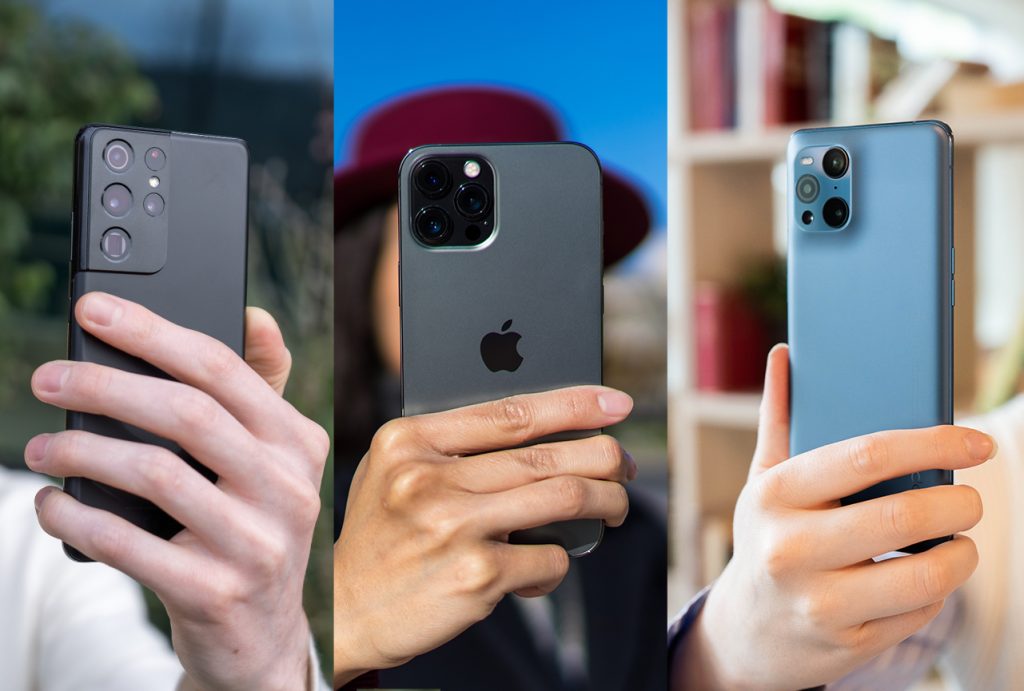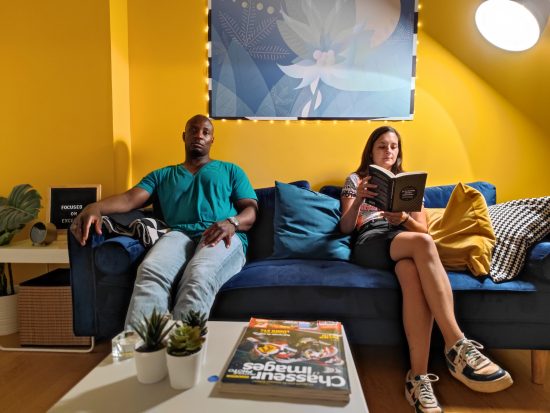Most phones in the ultra-premium category are flagship devices of their respective brands, packed with high-end camera components and designed to showcase the technological prowess of the manufacturers. On their flagship phones, the engineers try to expand what is possible in terms of smartphone imaging technology, implementing ever longer-range tele modules, ever wider freeform ultra-wide lenses, 8k and 4K video at higher and higher frame rates as well as new features like microscope lenses or tilting camera modules.
It’s therefore no surprise that the latest ultra-premium phones usually occupy the top positions in the DXOMARK Camera ranking. In this article, we are having a closer look at some of the best and most popular ultra-premium options for different use cases.
Best overall
- Huawei P50 Pro (DXOMARK overall score 144)
- Xiaomi Mi 11 Ultra (DXOMARK overall score 143)
- Oppo Find X3 Pro (DXOMARK overall score 131)
- Apple iPhone 12 Pro Max (DXOMARK overall score 130)
Released in July 2021, the Huawei P50 Pro is the current number one in the DXOMARK Camera ranking. It uses Huawei’s own Kirin 9000 chipset and packs four camera modules. The primary module is paired with a monochromatic camera which mainly helps enhance detail. There are also a 13mm-equivalent ultra-wide and a 90mm-equivalent tele, allowing for a very wide zoom range.
Not far behind in the second spot is the Xiaomi’s Mi 11 Ultra, which was released in April 2021 and was one of the first devices to feature a Qualcomm Snapdragon 888 chipset. This phone uses a triple-camera setup, with a 50 MP, 1/1.12” Quad-Bayer sensor — one of the biggest in current smartphone cameras – in the primary camera. It also features innovative technologies such as Dual Pixel Pro autofocus and Smart ISO Pro HDR and the 128° lens with f/2.2 aperture in the ultra-wide module and a 120mm equivalent tele module, making it a really good all-around device.
Oppo’s latest flagship phone, the Find X3 Pro, which was launched in March 2021, lags a few points behind the top duo. It cannot quite beat Huawei’s 2020 models Mate 40 Pro and P40 Pro either, but it is still a very strong contender. Like the Mi 11 Ultra, it features the recent Qualcomm Snapdragon 888 chipset. The primary camera uses a 50 MP 1/1.56” image sensor and for your zooming needs, the Find X3 Pro comes with an ultra-wide module with a 110.3° field of view and a 13 MP tele with f/2.4 aperture. This said, the Tele category is where the Oppo lacks the most compared to the Huawei and the Xiaomi. Although not tested under our protocol, a 3 MP microscope camera completes the Find X3’s camera setup.
Given it’s one of the most popular devices in this category we have also included the Apple iPhone 12 Pro Max in this article. The Apple flagship is the only device in our list that was not launched in 2021, but it still holds its own, placed just behind the Oppo Find X3 Pro in our ranking and outperforming some 2021 flagship models from Samsung or OnePlus. Its triple-camera setup with a 26mm equivalent primary camera, 13mm ultra-wide and 65mm tele offers good all-around performance.
Best for Photo
- Huawei P50 Pro (DXOMARK Photo score 149)
- Xiaomi Mi11 Ultra (DXOMARK Photo score 148)
- Oppo Find X3 Pro (DXOMARK Photo score 139)
- Apple iPhone 12 Pro Max (DXOMARK Photo score 138)
All four devices listed above provide excellent all-around image quality when shooting still images with the primary camera, covering most of your photographic day-to-day needs. However, if you are after the best camera for a specific use case there are some important differences. Let’s have a closer look.
Best for portrait photography
If you love taking people pictures, the current number one device in our ranking, the Huawei P50 Pro, might be just what you’ve been looking for. Its camera delivers well-exposed portraits, even in challenging high-contrast conditions and in dimmer light. Skin tones are pleasant, and images show high levels of details and very little noise. With less light, the autofocus can sometimes struggle, and in these situations it’s advisable to use touch-focus for best results.
If you shoot a lot of images with more than one person in them, the Xiaomi Mi 11 Ultra could be the better option, though. Its camera uses clever algorithms to sharpen the faces of subjects further away from the camera, giving the impression of a wider depth of field and keeping more people in focus.
Other than that, the Mi11 Ultra offers similar results for exposure, color, and texture/noise as the P50 Pro, except for low light where dynamic range is more limited and more detail is lost in the brightest and darkest parts of the image.
The Oppo Find X3 Pro and Apple iPhone 12 Pro Max are good options for portrait shooters, too. The Oppo is similar to the Huawei in so far that it is more adapted to single portrait shooting, due to its relatively narrow depth of field. The Apple, on the other hand, will let you capture group shots just like the Xiaomi. However, keep in mind that both cameras are slightly less reliable at giving you an accurate target exposure in low light, and portrait images show a tad more noise than the top two performers, giving your pictures a grainier look.
For those who want a DSLR-like look with a strongly blurred background for their portraits, using bokeh mode is a great option. The Huawei P50 Pro is again our top pick for this feature, with very efficient depth estimation and very natural-looking bokeh characteristics such as blur gradient and bokeh shape. The other devices don’t fall very far behind, though. Mainly depth estimation and blur gradient can sometimes be slightly less accurate, resulting in an overall slightly less natural bokeh effect.
Best for landscape photography
The Huawei P50 Pro is also the best pick for landscape photographers. With its wide dynamic range, the camera captures every detail of the scene, even in the darkest and brightest parts. The Mi 11 Ultra isn’t far behind but has a slightly higher tendency to clip highlights and shadows in challenging high-contrast scenes. Color is pleasant on both cameras although the Mi 11 Ultra can sometimes look slightly pink. Upon close inspection, the P50 Pro lacks a touch more fine detail than the Xiaomi but on the upside, noise is not visible at all.
The Oppo Find X3 Pro provides the same level of detail as the Mi11 Ultra, but noise levels are higher, resulting in a grainier image. The iPhone 12 Pro Max falls a bit more behind with slightly less detail and a bit more noise than the top performers.
The top three devices in the ultra-premium segment offer very versatile cameras and deliver excellent still image quality, whether you are shooting portraits or landscapes. The Huawei P50 Pro is overall the best, but it’s worth mentioning that it has some room for improvement in one important area: Preview. Your decision to take a picture or not will often be based on the preview image you see on the display. The Huawei’s preview image is much more limited in dynamic range than the actual capture which means sometimes preview and capture might look quite different. In those cases, you might want to take the picture anyway and hope it turns out ok – which on the P50 Pro it does most of the time.
Apple’s iPhone 12 Pro Max on the other might sometimes be slightly lacking behind in terms of overall image quality but is the best choice if want to make sure that what you see on your screen is what you’ll get in the final capture.
Best for Zoom
- Huawei P50 Pro (DXOMARK Zoom score 107)
- Xiaomi Mi11 Ultra (DXOMARK Zoom score 100)
- Samsung Galaxy S21 Ultra 5G (Snapdragon) (DXOMARK Zoom score 78)
The Zoom score includes the tele and wide sub-scores. In this section, we take a closer look at the best devices for zooming in and zooming out.
Best for ultra-wide
When shooting with an ultra-wide camera, one of the most important considerations is the ability to squeeze as much scene content as possible into the frame. With its 12mm equivalent focal length Xiaomi Mi 11 Ultra offers the widest camera in this list. However, at 13mm the P50 Pro’s focal length is only slightly longer and the camera manages better overall image quality, earning the Huawei the top score in the wide category. So if you’re willing to give up a little bit of field of view the P50 Pro is the better option, offering cleaner images, with less noise and artifacts.
The Samsung Galaxy S21 Ultra 5G (Snapdragon) provides a slightly narrower field of view at 14mm (the same as the entire S21 series) and although its overall ultra-wide image quality is very good, it lacks a bit behind the top two in terms of exposure.
Best for tele
When capturing details of a scene from long distance, the zooming capabilities of your camera are important. In this area, the new Huawei P50 Pro is the best device available. Its tele module with 90mm equivalent focal length (about 3x zoom in relation to the primary camera) offers detailed images, with well-controlled noise, allowing for the capture of small details even at medium and long-range zoom settings.
The Mi11 Ultra is a good option for even longer zoom distances. Its tele module comes with a longer 120mm equivalent focal length. The longer optical zoom allows for better quality at long distances but you pay a price at intermediate zoom settings. The camera uses field of view fusion for zoom ratios between 3x and 5x, using the output of the tele module for the center of the frame and filling in the edges with image data from the primary module. This results in visible sharpness differences between the center and edges of the frame. It’s therefore best to make sure the subject is centered in the frame.
The Samsung Galaxy S21 Ultra 5G (Snapdragon) deploys not one but two tele modules, at 72mm and 240mm focal length, to ensure good image quality across a wide zoom range. However, despite the impressive hardware it delivers slightly less fine detail than the top competitors and a bit more noise. This said, it’s a great option for zooming at very long zoom factors (around 10x) as the dedicated folded tele module delivers good image quality.
In the ultra-premium segment you’ll mostly find flagship-level devices. These are the models manufacturers use all of their latest technologies and high-end hardware in. So it is no surprise that these devices reach the top of our rankings in many categories. The Huawei P50 Pro and the Xiaomi Mi11 Ultra are both very strong all-around devices, covering all your photographic needs and making them a great tool to have in your pocket at all times.
Best for Video
- Xiaomi Mi 11 Ultra (DXOMARK Video score 117)
- Huawei P50 Pro (DXOMARK Video score 116)
- Apple iPhone 12 Pro Max (DXOMARK Video score 113)
- Oppo Find X3 Pro (DXOMARK Video score 111)
The ultra-premium segment offers the very best in terms of smartphone video. When recording while standing still, all of the top four devices offer effective video stabilization, keeping the scene as steady as possible when shooting handheld. Recording at 4K resolution they all deliver a high level of detail, too, but the Xiaomi Mi 11 Ultra is standing out, thanks to the best fine detail retention and very low noise levels. The Huawei P50 Pro and the Mi 11 Ultra both deliver videos with accurate target exposure and wide dynamic range, along with pleasant white balance and color rendering. With the Oppo Find X3 Pro, it’s best to avoid shooting video in low light because footage will probably be underexposed.
Those users who frequently record video while walking or running should pick the Mi 11 Ultra over the competition. It doesn’t reduce quite as much motion as the others when walking (although you’d have to watch very closely to spot the difference), it shows less sharpness differences between frames and therefore footage that is almost always sharp. The Find X3 Pro and Apple iPhone 12 Pro Max offer similar levels of constant sharpness, but they tend to show some jello effect, slightly deforming some areas of the image when there is movement. The iPhone 12 Pro Max also records video footage in Dolby Vision 10-bits HDR format by default. The benefits in terms of dynamic range are not massive but brightness and contrast rendition allow for a more pleasant experience when viewed on a compatible display.
The Mi 11 Ultra’s adaptive frame rate is another interesting feature for video. The camera records at 60 fps in bright light for very smooth footage, and automatically lowers the frame rate to 30 fps in dimmer light conditions, to preserve image quality. The Oppo’s strong point is the accuracy and reliability of its autofocus, even beating the Xiaomi and Apple devices, but not the Huawei.

















DXOMARK encourages its readers to share comments on the articles. To read or post comments, Disqus cookies are required. Change your Cookies Preferences and read more about our Comment Policy.